SEJournal Online is the digital news magazine of the Society of Environmental Journalists. Learn more about SEJournal Online, including submission, subscription and advertising information.
 |
As part of a new initiative for the Society of Environmental Journalists' 2024 annual conference in Philadelphia, PA, from April 3-7, the SEJ Publications team has organized an inaugural student newsroom to provide running coverage throughout the conference and beyond. Below, you'll find the stories and images from sessions and workshops, along with reporting on all-day tours.
SEJ Session/Tour: Breakfast, Books and Birds Brunch Closes Conference
Published April 18, 2024
By Sebastiana Lopez
An April 7 brunch featuring “Breakfast, Books and Birds” at the John Heinz National Wildlife Refuge at Tinicum in South Philadelphia closed out the annual Society of Environmental Journalists conference.
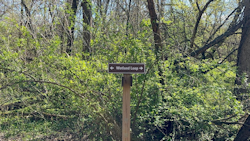 |
| The John Heinz National Wildlife Refuge in South Philadelphia, where SEJ conference attendees hiked the “wetland loop” trail of the refuge’s marshy landscape and saw a variety of ducks and other species. Photo: Sebastiana Lopez. |
Attendees toured birding spots around the refuge and engaged in panel discussions about the intersectionality of religion and environmental justice, and about reporting on nonhuman lives.
Tour leader Lamar Gore, refuge manager, identified Heinz as the largest remaining tidal marsh in Pennsylvania and addressed the area's environmental issues. Other refuge staff explained their responsibility for managing water levels around the wetland to accommodate wildlife throughout the seasons.
“We do have nesting ducks here: Wood ducks, black ducks, mallard ducks and a lot of the black ducks nest in the tidal marsh area,” Gore said.
In addition to providing public education, Gore also focuses on human-caused environmental hazards affecting nearby neighborhoods.
“The Eastwick community is surrounded by tank farms, the petroleum industry, the highway, the airport and landfills,” Gore said. “You have Black and Brown communities sitting right in the middle. We are trying to work with the community to address this.”
Later, one of two panel discussions, “The Faith + Earth Beat: A Template for News at the Intersection of Religion and Environment,” explored how environmental actions are driven by religious movements.
Moderator and investigative journalist, Julia Shipley, introduced a diverse group of speakers who focused on their particular religious efforts to bring awareness to environmental issues.
Israel Harris, an advocacy director and part of the Coalition on the Environment and Jewish Life in Scranton, Pennsylvania, emphasized the importance of education.
“Educational resources and educational wealth is something that is so important in our faith communities, and I think we share a lot of those goals. Using our faith community to empower voices, to speak up and also act,” Harris said.
The panelists also discussed how journalists could do better to amplify religious and environmental justice intersectionality in the media.
“Both the language and the questions you ask matter. The environmental issue isn't just an issue that affects some of us, it impacts more broadly,” said Katie Ruth, who is part of Pennsylvania Interfaith Power and Light.
Panelists further emphasized the importance of community-building, personal connections and identities to achieve environmental justice in our society.
“There are a lot of good things happening that hopefully can be highlighted and spotlighted to really show the impact they have,” said Julian Burnett, a senior community partnerships manager at solar firm PosiGen.
Sebastiana Lopez is a student at Temple University and a member of the inaugural SEJ student newsroom.
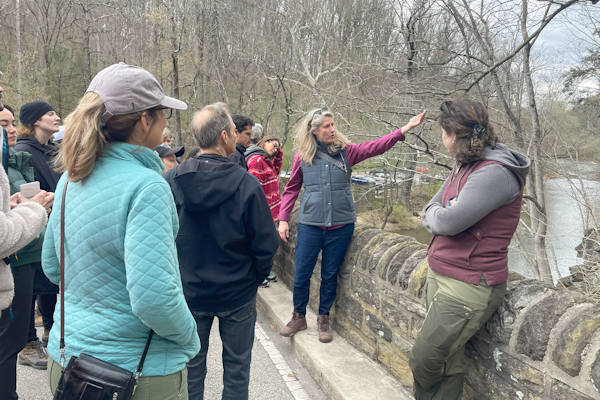 |
| Ruffian Tittman of Friends of Wissahickon explains that the SEJ tour has arrived on opening day of trout season. The fish is found in abundance in the creek. Photo: Shealyn Paulis. |
SEJ Mini-Tour: Journalists Hike Urban Wilderness on Wissahickon Valley Park Mini-Tour
Published April 18, 2024
By Shealyn Paulis
While Society of Environmental Journalists conference attendees spent most of their time in the historic urban center of Philadelphia, a few had the opportunity to explore a natural space within it during an April 6 mini-tour of Wissahickon Valley Park.
The park encompasses over 2,000 protected acres along a stretch of the Wissahickon Creek as it passes through northwest Philadelphia. A popular spot for outdoor enthusiasts, historians and even wedding-goers, the park houses over 50 miles of trails and provides a place for city dwellers to enjoy greenery.
The nonprofit group Friends of Wissahickon works year-round to maintain, preserve and protect the park, and has since 1942, explained Ruffian Tittmann, executive director of FOW.
Tittmann guided the tour of more than 30 SEJ attendees along a park trail while providing historic commentary and park information. She was joined by tour leaders Frank Kummer, environmental reporter for The Philadelphia Inquirer, and Rebekah Ward, climate and environment reporter for the Houston Chronicle.
Tittmann says FOW works to implement preservation practices and maintain a clean park.
But this can prove difficult, as it is such a popular summer recreation spot, she said. Parts of the park get very congested and polluted in the busy months when there can be more than 1,000 daily visitors.
Tittman added that frequented swimming spots pose an annual dilemma. “The Devil's Pool area is a very popular summer destination, but one of the big challenges of use in the Wissahickon,” said Tittman. “Really, one of the most beautiful places as well.”
Additionally, FOW applies a range of conservation efforts in the park. To fight eroding river banks and moving soils, Tittmann said the group prioritizes plantings that help “anchor” the bank. She also said that FOW provides a range of infrastructure to minimize human impact on the park, such as restroom facilities, and sustainable trails and bridges designed to limit erosion.
Intentional design of the park can be dated back to its inception, said Rick Howley, an environmental engineer with the City of Philadelphia Water Department, who joined the tour to provide infrastructure information and the history of the park. Original water system designs used the natural paths of the creeks and streams, with pipelines running next to/with them, he said. This structure lessened energy requirements to get water throughout the city.
While on the tour, the group of SEJ attendees was able to go on a scenic hike, sight an atypical seabird and enjoy spectacular views of Wissahickon Valley Park.
Commented Tittmann, “Wissahickon is a magical place.”
Shealyn Paulis is a student at Michigan State University and a member of the inaugural SEJ student newsroom.
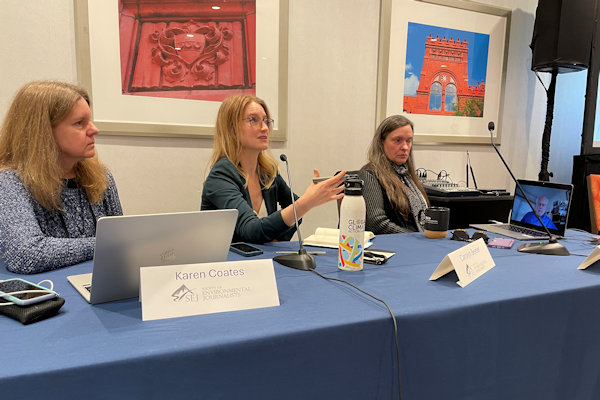 |
| Panelists (l-r) Karen Coates, Carolyn Beeler and moderator Susan Phillips, senior climate reporter/editor at WHYY News, addressed audience questions about the environmental impacts of war. Photo: Anna Barnes. |
SEJ Session: How To Cover Environmental Consequences of War: Humans First
Published April 15, 2024
By Anna Barnes
Death counts and political polarization often take the headlines when it comes to war. But what about the environmental consequences we often don’t recognize?
Carolyn Beeler, co-host of the public radio show The World, said she understands the difficulties in reporting on environmental issues when the death toll is looming.
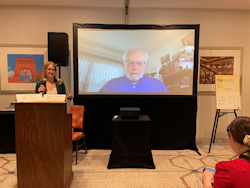 |
| Beeler shares her experience reporting on the environmental impacts of the Ukraine war, with virtual participation from Tareq Abu Hamed on the conflict in the Middle East. Photo: Anna Barnes. |
“How do you report on these stories when people are also dying?” Beeler said. “You put the human stories first, give the appropriate weight to these types of stories, and then show the environmental impact.”
Alan Robock, a professor at Rutgers University, expressed worry about the environmental impacts of a possible future nuclear war. “Temperatures will be below freezing, even in the summertime, and obviously this does have an effect on ecosystems and agriculture,” Robock said.
The human toll would be immense, even for survivors; in a hypothetical nuclear war between the United States and Russia, he said, almost everybody would starve.
Tareq Abu Hamed, executive director of the Arava Institute for Environmental Studies, who joined the conversation remotely from East Jerusalem, explained that the Middle East is a hotspot not just in terms of war but also for climate change, some of which can be attributed to the area’s ongoing conflict.
“The region is warming 20 percent faster than the global average,” Hamed said. “What is lacking in the Middle East is trust, people do not trust each other. And that prevents us, in the countries in this region, from working in a cooperative way to deal with the impact of climate change.”
While Robock looked to the future and Hamed talked about the present, Karen Coates of Mongabay shared the trailer of her documentary, “Eternal Harvest,” depicting the environmental effects still prevalent in Laos years after the bombing ended there.
“Seventy-five percent of the population is farming and yet, it's dangerous,” Coates said. “It's dangerous to dig, it's dangerous to go out into the forest and collect herbs, or try to look for food. It's dangerous to fish because there are probably more than 80 million live bombs in the ground.”
Anna Barnes is a student at Michigan State University and a member of the inaugural SEJ student newsroom.
SEJ Session: Climate Storytellers Need Care and Community
Published April 18, 2024
By Joshua Geaughan
Covering climate change and environmental justice poses an important question to journalists: How do we take care of ourselves?
Speakers at an April 5 panel on “Care and Community As a Climate Solution” at the Society of Environmental Journalists annual conference spoke to the repercussions of devoting your life’s work to covering climate change — everything from dealing with online hate to spending hours at a time reporting on the horrible effects of a worsening environment.
“There's a lot of trauma that we have to carry as journalists,” said freelancer Yessenia Funes. “It's a weight to carry. And many of us do this work because we care, right? There's so much of the work that fuels me and keeps me going. And there are other aspects of the work that can be really paralyzing and heartbreaking. It's a tough gig to carry that on a day-to-day.”
Speakers’ solutions to the mental health struggles journalists face were multifaceted.
Funes suggested journalists talk to other journalists and open up about the difficulties that come with environmental reporting. Jeje Mohamed, a senior manager of digital safety and free expression at Pen America, agreed that journalists want to talk to other journalists, even above mental health professionals. Building a community around the issues and creating a peer support network is an easy way to shift the load from one person’s shoulder to everyone's shoulder.
Matt Scott, director of storytelling and engagement at the nonprofit Project Drawdown, talked about the need to create a boundary between your work and your personal life as the first step in protecting yourself from the profession's challenges. “I think the issue makes us feel actually as if we need to keep going, like we can't rest, like we can't care for ourselves, when the reality is we can't do this work if we don't take care of ourselves and sustain ourselves to make it to the next day.”
But, added Scott: “One question I sometimes ask is: What does rest look like for you? But often people will have the blank stare of ‘What’s rest?’”
Panelists discussed whether these changes can happen in the newsroom. An in-house therapist seems like a radical idea, especially in journalism. But one part of shaping a caring newsroom is having an editor or a manager who understands the effects that the stories can have on journalists and works with their staff to avoid burnout by creating a safe space within the newsroom.
There are ways to avoid journalistic burnout, from enacting changes in the newsroom to simply asking a co-worker “How are you doing?”
In the end, there isn’t one correct way of dealing with the pressures journalism puts on its writers. “Find the thing that works for you,” Mohamed concluded. “That can be extremely simple, like blocking an hour of your calendar to just breathe, sit there, do something, take deep breaths. … There is no right or wrong answer.”
Joshua Geaughan is a student at Roger Williams University and a member of the inaugural SEJ student newsroom.
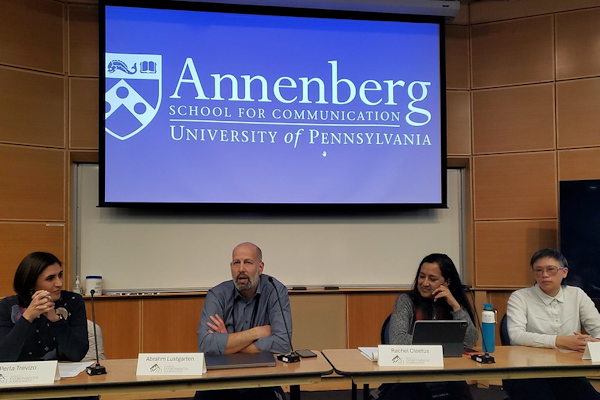 |
| Panelists for the April 5 “On the Move” session discussed future prospects of global migration due to the climate crisis, along with best practices for reporters and policymakers covering the story. Photo: Allison Beck. |
SEJ Session: Panelists Call for Human-Centered Climate Migration Reporting
Published April 15, 2024
By Allison Beck
Climate migration first drew the attention of ProPublica reporter Abrahm Lustgarten when wildfires sweeping California threatened his home there. In the end, it remained safe. But the experience was a reminder that due to climate change-related disasters, many others in the future won’t be so lucky.
Over the next 50 years, the climate crisis is likely to force an unprecedented global migration, including within the United States. New research indicates that as many as 160 million Americans will face rapidly degrading environments that force them to move elsewhere.
That much was made clear by panelists of an April 5 session at the Society of Environmental Journalists conference, which focused on climate migrants’ stories and how to cover the issues surrounding mass movement.
“This is a complex story, and it’s a story about human beings at the center, and safe shelter at its center,” said Rachel Cleetus, policy director of the climate and energy program at the Union of Concerned Scientists. “Migration, forced displacement, it is part of human history. People have been on the move since time immemorial. So when you tell these stories it’s important to ground it in that history and how it’s changing now.”
Increases in heat, droughts, wildfires, flooding and other climate change-related crises are only part of the equation, panelists said. Additional side effects, such as job loss, lack of food and water and increased regional conflicts will also push people to leave their homes.
Acknowledging complexity and humanity was key for the panelists, who said that only seeing statistics or broad strokes can feed into xenophobia.
“Look, we know climate’s going to lead to more people in this situation, so let’s just make sure we’re bolstering and centering these people in how we approach the challenge,” Cleetus said.
But while journalists should focus on the people impacted, they shouldn’t describe them as “climate refugees.” It’s a term that offers only limited legal protection and removes the nuanced reasons why people migrate, argued Kayly Ober, senior program officer for the climate, environment and conflict program at the United States Institute for Peace.
Instead, panelists said it was important to tell the full story of climate migration — that includes the human stories, the numbers behind them and the policy options that are available.
“Sometimes focusing only on the number loses the nuance and also may counteract some of that human dimension,” Ober said. “Tell the stories of people that have experienced displacement or have been forced to migrate in the face of different sorts of climate changes. The numbers don’t tell that story.”
Panel moderator Perla Trevizo acknowledged that the scope of the coming challenges could be demoralizing. She ended the panel by asking the speakers what gives them hope.
Lustgarten was adamant: “We are not doomed.” By reducing emissions and taking steps now to prepare for the changes that are coming, he said communities can avoid what could feel like doomsday scenarios.
Allison Beck is a student at Temple University and a member of the inaugural SEJ student newsroom.
SEJ Session: Rural Reporting Depends on Trust, Finding Common Ground
Published April 14, 2024
By Amalia Medina
When reporting in rural communities, journalists must “listen and shut up.”
That was the advice of former Native News Online managing editor and author Valerie Vande Panne, a panelist at a session at the Society of Environmental Journalists annual conference April 5 on unpacking rural reporting.
The panel sought to confront a key issue in rural reporting: helicopter journalism. The practice, which involves a reporter making quick trips to new towns to extract stories, fails to establish a connection. Because of that, it also fails to reflect communities accurately, panelists said. And contributes to sowing distrust in the media.
Vande Panne and her co-panelists — investigative freelance journalist Jen Byers, climate journalist Shreya Agrawal, editor of the Daily Yonder national rural news platform Tim Marema, and environmental reporter Claire Carlson, also of Daily Yonder and the panel’s moderator — agreed that covering communities requires trust built through meaningful relationships.
Whether that means going to a high school basketball game, chatting up a local diner or walking down Main Street, Vande Panne said reporters must get to know the people they are covering.
Agrawal said that when she prioritizes forging relationships, she also builds readership because the stories are the product of listening to the community’s concerns. This was how Agrawal approached reporting for the Malheur Enterprise in rural Oregon, for instance, where she covered the wider community and events, in addition to environmental stories.
“You’re publishing the stories for the community,” she said. “It’s not just about getting another byline.”
Even before a reporter enters a community, their work starts with shedding biases, Agrawal said. They also must know the community, as rural communities are not a monolith, and diverse perspectives often go overlooked.
Byers said applying a critical lens to the profession itself enables journalists to avoid perpetuating stereotypes in their work. This reflection establishes common ground, which Marema said facilitates connection.
Asking people their values will get a reporter farther than asking their political party, Marema said. Talking about specific issues they are facing will be more effective than using polarizing language. It’s about meeting people where they are, which reporters can reflect in their stories.
“When we describe things,” like climate issues facing rural communities, Marema said, “then we get people who live in other types of places that may have similarities and differences a chance to see where they might fit and how they can relate to that community.”
Amalia Medina is a student at Michigan State University and a member of the inaugural SEJ student newsroom.
SEJ Session: Making Whistleblower Stories Happen
Published April 14, 2024
By Wajeeha Kamal
ProPublica investigative reporter Sharon Lerner and Public Employees for Environmental Responsibility’s New England Director Kyla Bennett offered attendees at a Society of Environmental Journalists conference panel guidance on best journalistic practices for working with whistleblowers in order to provide the public with critical information without risk to the careers of those coming forward.
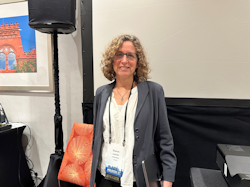 |
| Investigative reporter Sharon Lerner, following an April 5 whistleblowers panel that she moderated. Photo: Wajeeha Kamal. |
Lerner, a former reporter with The Intercept, reported in 2022 on whistleblowers who provided evidence that the U.S. Environmental Protection Agency had not adequately assessed the health risks of several new corrosive chemicals. Exposure to corrosive chemicals would cause immediate burns to the skin and lungs and can cause irreversible effects upon a first encounter, according to Lerner’s reporting.
“It’s hard to say how to make those [stories] happen,” said Lerner. “Seeking out people in their offices without going through their press office is certainly worth the time.”
Whistleblowers have faced harassment, denial of leave requests and reduced performance reviews at the EPA, and the issue has only gotten worse with their assessment of dangerous chemicals, Bennett said.
An anonymous EPA whistleblower on the panel said he didn’t immediately make a huge issue about documents being rewritten to remove information about the risks — cancer, miscarriage and neurotoxicity — associated with those corrosive chemicals back in 2020.
But the whistleblower said it got to a point where it was so “regularly pervasive [that] me and my colleagues felt like we had to step forward. … Whistleblowers were coming out of the administration left and right. That made a huge impression on me. Me and my colleagues knew we would probably be retaliated against, but it was like the behavior that was happening was so awful that we were like, we have to take this risk.”
Attendee Helina Selemon of the New York Amsterdam News said it was helpful to hear about ways reporters can handle themselves when dealing with careful and sensitive sourcing.
“That’s something I think a lot about as a reporter on the investigative team and who talks to people who either deal with trauma or dealing with tough situations,” said Selemon, a science reporter for The Blacklight, a new investigative unit for the Black-owned newspaper. “Understanding how to protect people who are thinking about the public good and the information that they have; … There are ways to protect them, yourself and the people potentially at risk.”
Lerner advised that whistleblowers are a special case, and said that reporters working with whistleblowers must deal with forms of classified and controlled unclassified information, so retrieving documents and sources to corroborate a whistleblower’s claims is often difficult.
“You can’t treat this like any other story,” she said.
Wajeeha Kamal is a student at Michigan State University and a member of the inaugural SEJ student newsroom.
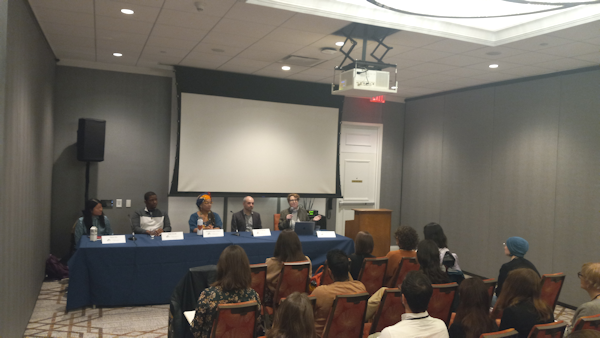 |
| Panelists and attendees at an April 5 session on shaping a more equitable, environmentally friendly food system. Photo: Claire Kelley. |
SEJ Session: Navigating the Path to Sustainable Food Systems
Published April 13, 2024
By Claire Kelley
A group of experts set out the challenges and possibilities in reshaping our food systems toward greater sustainability and justice, for an April 5 panel at the Society of Environmental Journalists annual conference in Philadelphia.
The panel session, “Eat Local, Just Transition, and the Search for Holistic Food System Solutions," explored the intricate relationship between our food choices and the environment, addressing the challenges and trade-offs inherent in our food systems and the give-and-take in the need for industrial agriculture as opposed to small-scale farming.
Panelists’ insights underscored the need for a holistic approach integrating environmental stewardship, social equity, and community empowerment. As consumers and advocates, they reminded the attendees of their agency in driving positive change through mindful choices and collective action.
Journalist Feini Yin, a fisheries specialist with the North American Marine Alliance known for her work in revitalizing local seafood practices as a storyteller and strategist with Fishadelphia, emphasized the necessity for seasonal, controlled, and locally sourced seafood to counteract overfishing.
Yin also stressed the importance of aligning fishing practices with natural migration patterns and availability, highlighting the disconnect between consumers and their food sources.
Also during the session, Malaika Hart Gilpin, executive director of One Art Community Center, underlined the critical role of public accountability in stewarding land resources. She emphasized the need for a meaningful connection to the land, saying, "We need to have that connection to report. … We need to honor it."
Matt Scott of Project Drawdown and Garrett Broad of Rowan University contributed their perspectives on justice within food systems. Broad emphasized the need for a just transition towards sustainable agriculture, recognizing the industry's disparities in access and opportunity. Scott expanded on the theme by discussing the intersection of food justice and racial equity, advocating for policies that prioritize marginalized communities in food system planning.
Panel moderator Jenny Splitter, editor-in-chief of Sentient Media, added to the conversation by addressing the broader context of holistic food systems. She discussed the complexities of achieving sustainability, stressing the importance of systemic changes to foster a more equitable and environmentally friendly food landscape.
Overall, the session’s speakers highlighted the power of collaboration and advocacy in shaping a food system that nourishes both people and the planet, in hopes of inspiring attendees to be a driving force for positive change and leaving them with a renewed sense of purpose in advancing toward a more just and sustainable future through one’s food choices and collective activism.
Claire Kelley is a student at Roger Williams University and a member of the inaugural SEJ student newsroom.
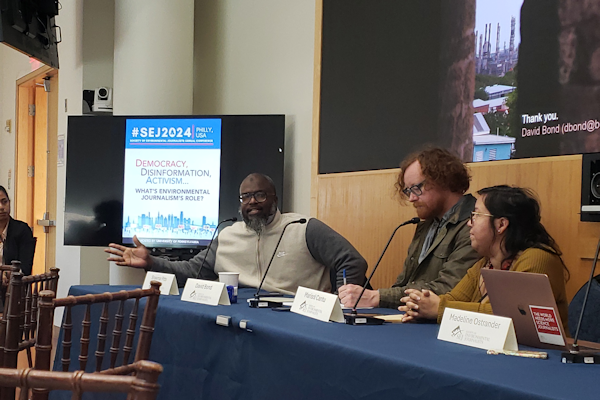 |
| Panelists (pictured from left to right) Shawmar Pitts, David Bond and Marisol Cantú, at a session on the impact for communities of the energy transition and closure of oil refineries. Photo: Allison Beck. |
SEJ Session: A Just Transition for Oil Towns — Community Knowledge and Collaboration Is Key
Published April 13, 2024
By Allison Beck
Marisol Cantú’s baby brother spent his first birthday in an incubator.
“I couldn’t hold his hand,” she said. “I didn’t fully understand what that meant, I just understood that he couldn’t breathe, and I could.”
Cantú and her brother grew up in Richmond, Va., in the same neighborhood as a major Chevron oil refinery. It took years for her to understand that the reason for the health issues that plagued not only her family but her entire community were directly caused by the facility.
Cantú, who now works with the Richmond Progressive Alliance to hold the community’s polluters accountable, believes having the Chevron refinery shut down is not only wanted by the community but necessary.
The Society of Environmental Journalists conference session, "A Just Transition for Oil Towns," held April 5, featured experts from academia, activism and journalism discussing how communities can address the impact of oil refineries and reshape them for the future.
Panelists spoke about their experiences in research, community organizing and reporting around the neighborhoods and cities impacted by oil refineries.
David Bond, associate director of the Center for the Advancement of Public Action at Bennington College, said that the community he works with in the U.S. Virgin Islands has struggled to see change, as many institutions — the governor, bankruptcy court, and even the U.S. Environmental Protection Agency — put up little resistance and, he added, even enabled the oil refinery to continue poisoning the community.
In one case, there was a major leak at the St. Croix refinery — members of the community were sealing doors and windows to protect their children, who were unable to breathe as a result. The refinery put out daily news releases saying that their facilities were safe, and the local hospital said that no one had come to them with serious related health concerns.
“It was completely false,” Bond said. “It turns out much later, they weren’t even operating fenceline monitoring equipment. They were just issuing assurances that had no basis in fact.” He and his team surveyed the community themselves and found that at least 65 people had sought medical assistance over the course of four months.
Making that information available not only to journalists and policymakers but to the community itself can have a major impact. “So many of the people that we talked to thought they were going crazy. They thought they had an issue, they thought they were all alone in it,” he said.
Something similar happened in Grays Ferry, a neighborhood in South Philadelphia that stood right next to the Philadelphia Energy Solutions oil refinery. Residents were only made aware of how serious its effects were after an environmental justice organization, Philly Thrive, was started in their neighborhood.
“I remember having a conversation with my dad maybe a few years before that wondering why on every household, on every street in our neighborhood, someone has asthma, cancer, heart disease, some kind of sickness related to breathing mostly, and we couldn’t figure out why,” said Shawmar Pitts, a lifelong community member and now co-director at Philly Thrive.
“From that day on, it was on,” Pitts said. The organization launched a campaign to get the refinery to pay for the pollution it caused — but it soon filed for bankruptcy. Community members are still fighting for reparations to their community and to make sure that the land is not reused for the fossil fuel industry.
What happens when the refineries go away? Communities often rely on the refineries for jobs and funding, either through taxes, community benefits agreements, scholarships or other support. Cantú said that switching those workforces to decommissioning refineries and working in green energy is key.
That means building connection around mutual points of concern for community members — worker safety and health, public well-being and other such issues. Presenting people with the facts of refineries’ impact is key, Cantú said.
All panelists highlighted the same approach for journalists: Be there for the community and let them guide reporting.
“We really need to come to the table together and build relationships, in particular build around mutual points of concern: worker safety, community safety, public safety, public health. This is on the minds of all of our workers,” Cantú said. “They’re dying young, their families are being born with cancer.”
She added that journalists and activists need to present people with the facts of refineries’ negative impact to dispel the narrative that they are “good neighbors.”
Said Cantú: “Also, showing up for them. I showed up on the line at 3 o'clock in the morning with coffee. We, environmental justice advocates, organized right alongside labor to build a relationship for decades. And so this was really critical for us.”
Allison Beck is a student at Temple University and a member of the inaugural SEJ student newsroom.
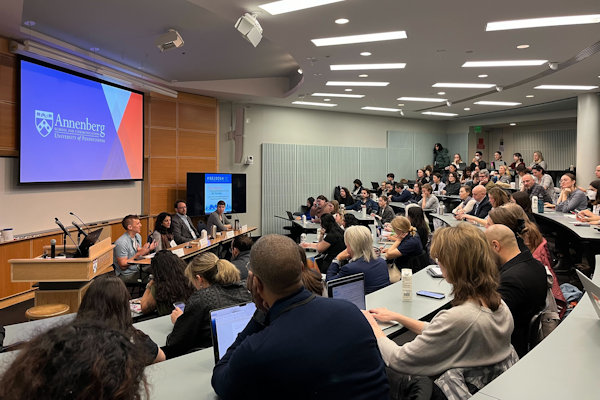 |
| Panelists and audience at a session on reporting about biodiversity at the Society of Environmental Journalists conference in Philadelphia on April 5. Photo: Kyle Bagenstose. |
SEJ Session: Making Obscure Animals and Ecosystems Compelling Main Characters
Published April 13, 2024
By Anna Pellegrini
The world is full of countless ecologically valuable, if obscure, species. But many of them are misunderstood by humans. To remedy that reality, an April 5 panel of reporters at the Society of Environmental Journalists conference addressed the importance of reporting on biodiversity.
Vox senior reporter Benji Jones, who moderated the session, prompted each panelist to talk about a species of special interest. Bethany Brookshire, a freelance science journalist and author of “Pests: How Humans Create Animal Villains,” used pigeons as an example. She explained how it was no fault of pigeons that their species is considered a ‘pest;’ rather, the designation is purely a human construct.
Brookshire said she also found it fascinating that at one time humans admired pigeons, using their excrement for fertilizer and the birds themselves as messengers. But as soon as those uses became obsolete, they came to be seen in a negative light.
“It goes so quickly from this beautiful, innocent, charming bird that Darwin wanted to write an entire book about, to a rat with wings,” Brookshire said. “The pigeon is the outdated iPhone of the animal world.”
Douglas Main, a freelance reporter, spoke of a story he wrote about murder hornets as an example of how a journalist could report on a species with negative connotations and use it to instead educate readers on the value of so-called pests. “Be curious, maybe learn. If it can spur people to learn about their native hornets, that would be awesome,” Main added.
Maya L. Kapoor, an engagement manager and freelance journalist covering climate, relayed a story she wrote about plans to use genetic engineering to bring back the American chestnut tree, which at one time spread throughout the Appalachian Mountains but is now functionally extinct. Kapoor explained how when she was approaching her story, she took a different angle by examining the relationships between these trees and humans over time.
Brookshire agreed that focusing on connections to humans is typically a valuable tactic. “We are an extremely selfish species,” she added.
To make stories compelling, panelists also suggested that journalists tie their reporting about obscure animals and ecosystems into greater, pressing themes. Main suggested, for example, that a story about the decline in ice worms could be a novel way to report on the loss of polar ice sheets due to climate change.
“Think of the species as a doorway into a larger concept,” Kapoor said.
Brookshire added that while climate change and pollution are indeed important global threats, humans also need to be reminded of why the natural world is worth fighting for. Said Brookshire, “Joy is more motivating than misery.”
Adam Litchkofski contributed to this report.
Anna Pellegrini is a student at Roger Williams University and Adam Litchkofski is a student at Temple University. Both are members of the inaugural SEJ student newsroom.
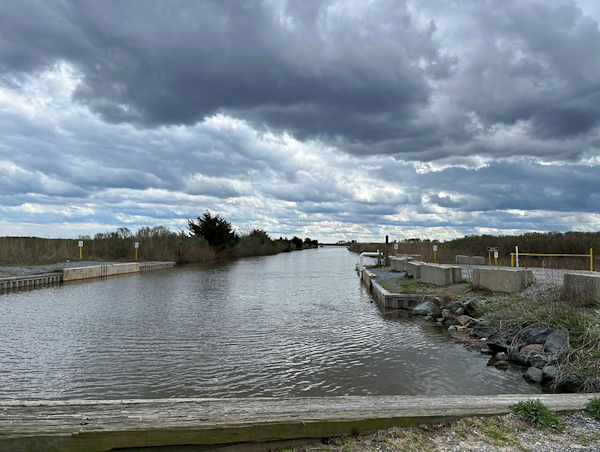 |
| A saltwater marsh reserve located at the Prime Hook National Wildlife Refuge. The final stop of a #SEJ2024 tour of Delaware sites, the refurbished refuge hosts 10,000 acres of land that have been connected to a $36 million project tasked with restoring and protecting the Delaware Bay environment. Photo: Anna Pellegrini. |
SEJ Tour: Delaware's ‘Holy Trinity’
Published April 9, 2024
By Joshua Geaughan
"Chickens don't pee. That's probably all you will remember from this."
That avian axiom from Mike Levengood, chief animal care officer at Perdue Farms, might have drawn snickers from #SEJ2024 conference attendees touring sites in the neighboring state of Delaware on April 4. But it also drew attention to one of the state’s biggest businesses — poultry.
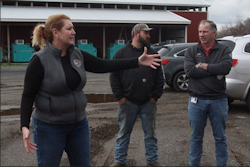 |
| Speakers (l-r) Holly Porter, Ryan Greer and Mike Levengood address SEJ attendees regarding poultry farm practices. Photo: Joshua Geaughan. |
“Chicken farming is the number one industry here. It's the number one economic driver,” explained Rachel Sawicki of Delaware Public Media, and one of the tour leaders. But the state is far from rural. “We've got a bit of everything. There is the city feel in Wilmington and then you have our agriculture industry and we got our beaches. And those are our three main economic drivers. It's our holy trinity, our big three.”
At another stop, on the outskirts of Wilmington in the marshland of the Russell W. Peterson Wildlife Refuge, attendees visited the DuPont Environmental Education Center. There, they heard from Matthew Williams, director of the center, and Mark Nardone, its director of advocacy, about the long history of the refuge. But along with the the return of a wide variety of animal species into the protected lands, they shared fears of a future garbage landfill overspill on adjacent government and private landfills.
Up the road, off Route 9 in northern Delaware, the tour participants heard from Karen Igou, a climate, ecological and social justice organizer who works with various communities, including in north Wilmington. She spoke of what she characterized as the city government’s incompetence in fixing the systemic sewer overflow problem, which was worsened by 2021’s Hurricane Ida.
“Even now — it's been two and a half years — the only remediation that the city of Wilmington has done is they put a tarp over the bridge by the river breach. So to me, that is absurd," Igou said. "And it has motivated me to do everything I can.”
Another environmental justice organizer, Jeffrey Richardson of the community-focused solar tech company Imani Energy, also touched on the growing political issue of environmental justice and the negative impact he believes large corporations have on the pace of environmentally friendly legislation. Richardson pointed to the example of the lack of safe drinking water in the Delaware area, citing a report put together by the U.S. Environmental Protection Agency in 2022 saying that Delaware is “number three in the nation for toxic releases.”
The final stop of the tour, the refurbished Prime Hook National Wildlife Refuge, hosts 10,000 acres of land that have been connected to a $36 million project tasked with restoring and protecting the Delaware Bay environment. According to Bart Wilson and Susan Guiteras of the coastal Delaware National Wildlife Refuge complex, over the three years after Hurricane Sandy in 2012, they have transformed the refuge from a manmade freshwater marsh for hunters to a semi-stable saltwater ecosystem.
Joshua Geaughan is a student at Roger Williams University and a member of the inaugural SEJ student newsroom team.
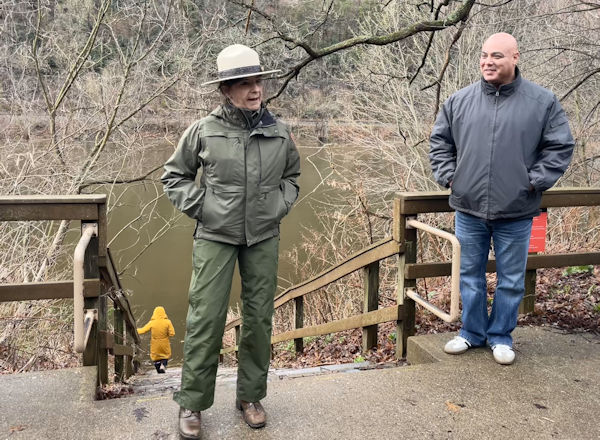 |
| At Kittatinny Point, National Park Service’s Kathleen Sandt explains the history of the Delaware Water Gap National Recreation Area to an #SEJ2024 tour group, as Lenape representative Levi Randoll observes. The spot has a complex history as previously private property that now serves as a visitor center. At the bottom of the steps, the normally sandy beach is underwater due to heavy rainfall. Photo: Shealyn Paulis. |
SEJ Tour: Gap Over Future of Delaware Water Gap
Published April 8, 2024
By Anna Barnes and Shealyn Paulis
The Delaware Water Gap National Recreation Area, a national reserve bordering central Pennsylvania and New Jersey, has a complex history of local disagreement and stolen land.
The 40-mile portion of the Delaware River, the longest free-flowing, undammed river east of the Mississippi, is also a source of pride for local preservationists — activists fought the proposed construction of the infamous Tocks Island Dam for over a decade and won.
Long before then, the same lands were taken from the Lenape people, the Indigenous tribe native to the area. They were removed from their land and displaced to federal reservations in Oklahoma.
Attendees from the #SEJ2024 annual conference, who toured the reserve on April 4, heard from Kathleen Sandt, a public affairs specialist for the National Park Service, which oversees the reserve. She acknowledged to SEJers the tumultuous history of the area, especially over the use of eminent domain to take property during the dam dispute.
Longtime Pennsylvania resident John Donahue, a former National Park Service superintendent, told tour attendees: “We're always making sacrifices. And I don't want to forget the sacrifices that were made by the people who once lived and occupied this area. They had, again, thriving businesses, homes, some of the finest farmsteads in the area, and they lost it all to federal acquisition, for this dam folly.”
Donahue, who is now president of the Pinchot Institute for Conservation, advocates for a local initiative to turn the recreation area into a national park and Lenape preserve. He wants the park rebranded for preservation and sustainability, for recognition of the Lenape people’s ancestral land and to protect recreational usage.
“We think this area, the Delaware Water Gap, is one of the most spectacular places that you can go to,” Donahue said. “At least a small portion of it should be designated as a national park.” Donahue also made a case for the economic benefit of increased visitation, especially to the local economy, from a national park designation.
Sandt believes the change would make little difference in day-to-day activities in the reserve. “The laws and regulations are the same, the management policies are the same, the funding strategies are the same, there is absolutely no difference,” she said. “Except that we would need to put up a whole lot of new signs.”
Not everyone is on board. Resident and community activist Sandy Hull, who previously fought the dam project, is opposed to the creation of the national park and heads the local “No National Park” campaign formed to block the proposal.
“It cost me a marriage. It cost me a lot of stuff to fight that Tocks Island Dam and I'm not about to give up and let this area become something that it should not be,” Hull said.
Local resistance stems from renewed concern over eminent domain, as well as from potential loss of recreational and hunting areas surrounding the reserve, she said. Hull added that the group has the support of several state senators, members of Congress and a state-recognized Lenape tribe.
Levi Randoll, the cultural preservation chair of the federally-recognized Delaware Tribe of Indians, told SEJers there is an increased interest within his community to visit their homeland and the tribe hopes to have a position there regardless of national park designation.
“Since we are removed into Oklahoma, or should I say the Indian Territory, we have a huge interest in bringing our people back here,” Randoll said.
Anna Barnes and Shealyn Paulis are students at Michigan State University and members of the inaugural SEJ student newsroom team.
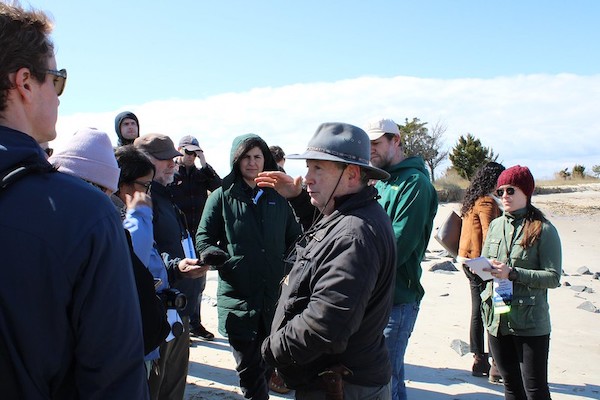 |
| Money Island resident Tony Novak, above in center, speaks with SEJ conference attendees about New Jersey's Delaware Shore development and shore erosion at Money Island Marina's beach. Photo: Gabrielle Nelson. |
SEJ Tour: Unearthing Climate Change Challenges Along Delaware Bayshore
Published April 6, 2024
By Christa Young
New Jersey’s Delaware Bayshore isn’t called "the road less traveled" without reason. Persistent rainfall in the region, exacerbated by ongoing global warming, has increased the amount of wetland in this area.
Journalists, scientists and conservationists are uncovering data showing that remote rural communities there, like Money Island in Cumberland County, will be flooded with water soon if politicians and state officials don’t take action fast.
Roughly three dozen attendees of the #SEJ2024 conference traveled to Money Island, the smallest and most remote rural hamlet in the county, the first stop on their daylong traverse of a 70-mile stretch of virtually untouched Delaware Bayshore coastline in southeast New Jersey.
There they met Tony Novak, a longtime resident and controller of BaySave, a nonprofit organization that focuses on sustainability. Novak, who has called the island home for three decades, highlighted the rapid erosion caused by rising sea levels, placing homes at risk of significant damage and deterioration.
In earlier years, Novak was traveling with what was then referred to as the Community Sea Level Rise Response Team. During their expeditions, Novak brought attention to the swift land degradation and shared his views with local government officials, which were met with disfavor.
Later, in 2018, the state of New Jersey filed a lawsuit against Novak, BaySave, his children, his father and other nonprofit organizations, for allegedly not acquiring the proper permits needed for filling in the wetlands.
Novak says the New Jersey Department of Environmental Protection is intentionally denying specific permit requests as one of many tactics to prevent the stabilization of Money Island.
Previously, the town had prominently displayed "no retreat" stickers concerning Delaware Bay. Novak's team suggested their removal, as the water levels were indeed receding, signaling the need for action to protect the land and its inhabitants. Novak said that he was viewed as making too much ‘noise’ about the environmental decay of Money Island.
"That did not go well," Novak shared. "A couple of them got together with a plan to take me out. They disabled me for a couple of years. When I finally recovered, it was just about the time that we got wiped out by [Hurricane] Sandy," Novak recounted.
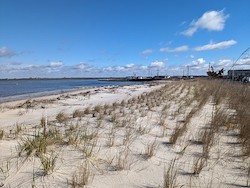 |
| The Money Island shoreline showing recent rehabilitation. Photo: Gisele Neuls. |
Many of the affected homes were weekend retreats for families from the southern part of the state. Residents were presented with buyout offers as part of an ongoing demolition process led by the NJDEP through a program known as Blue Acres, which aims to free up the land to function as natural flood storage, wetland or open space.
Tour attendees also heard from representatives of the American Littoral Society, which is under contract to monitor the island and is currently restoring habitat for wildlife and promoting conservation.
A habitat restoration project manager, Shane Godshall, said that at Money Island, his team was able to facilitate dredging a channel to create habitat for horseshoe crabs and red knots.
“Essentially what was here before was not conducive to horseshoe crabs,” Novak said. Now, to utilize the space, the NJDEP is taking down homes to restore the land to marginal habitat for the crabs and the birds that are keystone species for the bay.
Novak acknowledged that the future of Money Island is uncertain and that he doesn’t have high expectations for the local government to provide help for the island.
‘‘My plan is just to go to a slow, soft footprint. Enjoy what we have here. It's a wonderful place,” he added, “until the bugs show up.”
Christa Young and Gabrielle Nelson are students at Michigan State University and members of the inaugural SEJ student newsroom team. Gisele Nuels is a Ph.D. candidate at MSU and a teaching assistant in the journalism department. She serves as a mentor in the student newsroom.
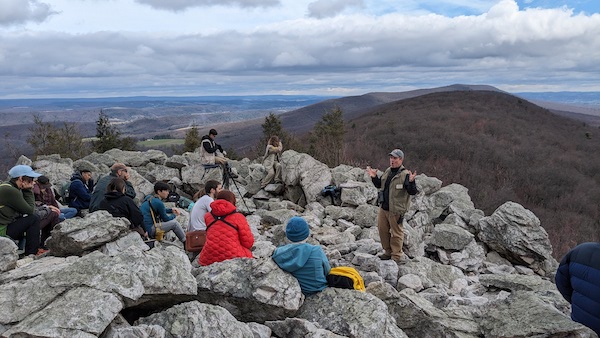 |
| Hawk Mountain Sanctuary Senior Research Biologist Dave Barber answers questions from SEJ attendees at a lookout on April 4, 2024. Photo: Daniel Schoenherr. |
SEJ Tour: Revolutionary Raptors — Hawk Mountain Sanctuary Takes Attendees Birding Along the Appalachian Trail
Published April 6, 2024
By Daniel Schoenherr
Tucked away in the foothills of Appalachia lies Pennsylvania’s Hawk Mountain Sanctuary — a center for environmental education and a flyway for thousands of raptors each year.
On April 4, Society of Environmental Journalists members and others attending the #SEJ2024 annual conference had the opportunity to catch the beginning of the raptor migration season at Hawk Mountain. Jason Hall of Philadelphia’s In Color Birding Club led the reporting tour.
In Color helps diverse communities recognize the potential of Philadelphia’s underfunded green spaces and see the magic of immersing oneself in the state’s natural environment, Hall said.
“[Hawk Mountain] is a very special spot along the Appalachian Trail because of its conservation studies,” he said. “We bring out our In Color club here quite often and people love it every time of the year.”
Hall wanted SEJ attendees to see the magic, too. The “Revolutionary Raptors: Hawk Mountain’s Role in Equity and Ecology” tour took attendees down the mountain’s primary sanctuary trail to see passing birds at lookout spots with expansive views of the region’s landscape.
“People are coming all the way to Philadelphia to talk about climate change’s impact on nature. Why not get you guys out of Philadelphia a little bit? This is a great trail for it.”
Hawk Mountain Sanctuary’s senior research biologist, Dave Barber, educated attendees along the trail about the significance of the group’s annual hawk migration count, which takes place each spring and fall.
“Many raptors have really large home ranges so you can’t monitor a population very easily,” he said. “The best way to do that is through counts at migration corridors like Hawk Mountain.”
In 1960, the sanctuary’s bald eagle counts were used as evidence in Rachel Carson’s “Silent Spring,” Barber said. Data on the declining maturity of documented eagles in the area helped pinpoint the source of their population decline: unborn chicks.
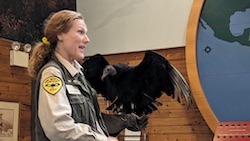 |
| “It’s one thing if we tell you about raptors and how awesome they are,” she said, “but there’s nothing like meeting one up close and personal to really inspire someone to care and protect these species.” — Jamie Dawson, Hawk Mountain Sanctuary’s education director. Photo: Daniel Schoenherr. |
The sanctuary has educated the public for decades about the significance of preserving habitat for raptors through outreach and group learning programs, said Hawk Mountain President Sean Grace.
“In the 1990s, we wanted to expand our mission and what we do,” he said. “The three legs of the stool that hold up Hawk Mountain are the stewardship of sanctuary lands, science and studying and, of course, education.”
Hawk Mountain Sanctuary education director, Jamie Dawson, presented the migration patterns and biology of Pennsylvania’s migrating raptors, complete with a live demonstration using three of the group’s birds. As she spoke about the benefit of landowners having bird boxes on their property, a black vulture was perched on her arm.
“We have many awesome humans and we have many awesome raptor ambassadors on our team,” she said, referring to the sanctuary’s birds. “We want to inspire sanctuary guests to take direct conservation action for raptors.”
Daniel Schoenherr is a student at the Michigan State University Knight Center for Environmental Journalism and a member of the inaugural SEJ student newsroom team.
SEJ Tour: From Farmbelt to Pinelands
Published April 5, 2024
By Astrid Code and Ava Chatlosh
An April 4 tour of the hidden rural lands and stories of New Jersey, organized by Frank Kummer from The Philadelphia Inquirer and writer Christine Woodside, took SEJ members to southern New Jersey farms and the Pinelands National Reserve, where guest speakers encouraged attendees to engage critically with the history of rural lands, highlight Indigenous perspectives and learn about farming practices.
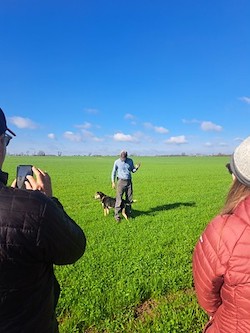 |
| Nino the Dog interrupts farm owner Eric Buzby's explanation of cover crops. Photo: Ava Chatlosh. |
At a stop at the A.T. Buzby Farm, owner Eric Buzby spoke on the pros and cons of organic farming. Buzby said some parts of his farm use organic practices but aren’t certified organic by the U.S. Department of Agriculture.
“Typically, people associate organic production with something that's better for the environment, better for the consumer and maybe better for the work environment on the farm,” Buzby said. “And while that might be true of some well-managed organic farms, it also could not be true. Organic pesticides — they're not certified to be safer.”
Buzby, who said he prioritizes the implementation of sustainable agricultural practices on his farm, began the farm tour with a conversation on erosion. Not only does Buzby use cover crops like ryegrass and clover seeds in the winter to avoid erosion but his farm pioneered a no-till farming strategy in the early 2000s. The approach minimizes soil disturbance, resulting in increased organic matter and decreased erosion, which also means more soil fertility, less fertilizer use and higher yields.
The tour then moved inside greenhouses, where Buzby uses hydroponic buckets to grow tomatoes. The tomato leaves were covered in sawdust containing predatory mites that prey on thrips, a tiny beady-eyed insect. Thrips feed on tomatoes and increase their disease susceptibility, which Buzby says has a major impact on his bottom line.
“They’re basically trying to make me go bankrupt,” Buzby said.
Tour attendees then visited the Cohanzick Nature Reserve, which was recently transferred to the Native American Advancement Corporation. NAAC President Tyrese Gould Jacinto and a panel of Native Americans spoke on the effect of Western culture on Indigenous communities, for instance noting that doctors have discouraged them from using traditional medicines and herbs that come from their land.
Tour attendee Olivia Gieger, a New York University student, said it was valuable as a journalist to hear Gould Jacinto’s perspective.
“I think (today) was a really good example of, the story doesn't need to be necessarily about Indigenous people, but they have a piece and a voice in whatever story you may be telling,” Gieger said.
 |
| Todd Wyckoff, state forester for New Jersey Forest Service, accompanied attendees through the New Jersey Pinelands, highlighting the goal to plant 10,000 acres of Atlantic white cedar over the next ten years. Photo: Ava Chatlosh. |
Attendees also visited Seabrook Farms in Upper Deerfield Township, where they learned the history of what was once the world’s largest industrial vegetable farm. From the 1920s to the 1950s, the farm’s workforce included Japanese Americans from internment camps, displaced Estonians and other workers of 25 different nationalities. Author John Seabrook and Rutgers University history professor Andrew Urban spoke on the history of the Seabrook family and about their upcoming books.
At another tour stop in the Pinelands, Todd Wyckoff, state forester for New Jersey Forest Service, asked journalists to think about how centuries of deforestation by profit-seeking enterprises still shape the Pinelands today. According to the NJFS, there were once more than 125,000 acres of Atlantic white cedar in New Jersey, but only 25,000 acres remain today (one-fifth of the nation’s total).
Wyckoff is overseeing efforts to plant 10,000 acres of Atlantic white cedar back into the landscape over the next ten years. They will be planted inland in an area protected from sea level rise due to climate change.
Tour leader Woodside offered this as an example of why journalists should examine the impact of history as they cover environmental issues.
“Understanding the history is a really important part of covering the environment, because when you go to a piece of land, … it's not just what you're seeing in front of you, it's everything that happened to it over hundreds of years before,” Woodside said. “I think we tried to show that today, both in modern times and long ago.”
Astrid Code and Ava Chatlosh are both students at the University of Michigan and members of the inaugural SEJ student newsroom team.
 |
| Michael Mann, author of “The New Climate War” and one of the climate scientists at the center of the trumped-up “ClimateGate” scandal, and Kathleen Hall Jamieson, author of “Cyberwar,” “Creating Conspiracy Beliefs,” “Democracy Amid Crisis” and numerous other books, at a disinformation workshop lunchtime discussion. Photo: © Dale Willman. |
SEJ Workshop: Combating Climate and Science Disinformation
Published April 14, 2024
By Lindsay Bowen
More than 100 journalists, students and others gathered for a day-long workshop on “Combating Climate and Science and Disinformation,” on April 3, at the Society of Environmental Journalists conference.
Amy Westervelt, founder and executive editor of Drilled Media, an investigative reporting project on climate, moderated the initial panel, during which four media professionals from various organizations discussed the origins of climate disinformation. Speakers agreed that much of modern climate denial is rooted in disinformation spread by the fossil fuel industry.
In addition, Melissa Aronczyk, public relations professional and professor of media studies at Rutgers University, described the revolving door of personnel between public relations, government and environmental groups, and said that as a result, much of the same messaging can be found in each, ultimately influencing the way Americans think about environmental politics.
“That set of connections that the individual or group of individuals is creating is also really key to understanding how the PR infrastructure is so embedded into our way of thinking,” she added.
Big oil companies like ExxonMobil, for instance, achieved this impact through “advertorials,” or ads disguised as editorials. Geoffrey Supran, professor of environmental science and policy at the University of Miami, also explained how Exxon contributed quietly to the science of climate change, while at the same time promoting doubt about that same science.
A second panel of media experts also discussed philosophical approaches to reporting on climate change. Phil Newell, associate director of science defense at the nonprofit climate news service, Climate Nexus, explained how to use the “truth sandwich” story structure to debunk climate deniers: fact, myth, fallacy, fact.
Newell added that a reporter does not have to be a scientist to rebut climate change disinformation. “You don’t accidentally cherry-pick three years out of a 20- or 30-year trend, it’s always intentional,” Newell said. “I’m not a math guy. I spent 10 years debunking people, it was never about the numbers. It’s always about the logic, it’s always about, is that a real expert or is that somebody who is paid to lie to you.”
Influential climate experts Michael Mann and Kathleen Hall Jamieson, professors and directors of science-related centers at the University of Pennsylvania, discussed climate research, the state of science communication and its effects on climate progress, during a lunchtime session on the intersection between disinformation research and climate science.
The workshop closed with a lightning round of journalists sharing their high-impact investigative pieces.
Lindsay Bowen is a student at Temple University and a member of the inaugural SEJ student newsroom.
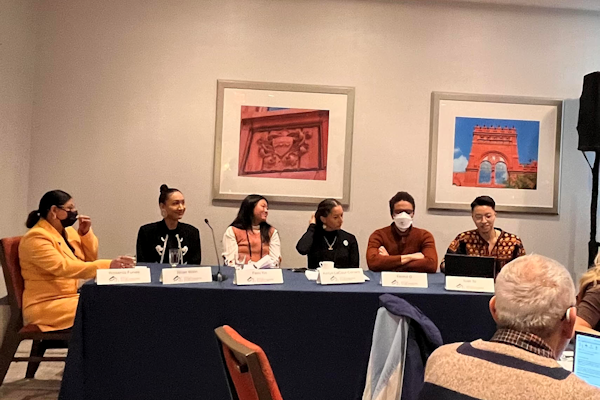 |
| Panelists at a workshop on watershed policy at the Society of Environmental Journalists conference in Philadelphia on April 3. Photo: R.J. Franceschini. |
SEJ Workshop: Watersheds — Local Lessons, Collective Solutions
Published April 13, 2024
By R.J. Franceschini
The challenges of achieving clean water in the United States are complex, with politics, agriculture and economics complicating efforts to clean up pollution and to manage the country’s myriad river basins and waterways.
Attempting to find a path forward were a series of panels at an all-day workshop April 3 at the 2024 Society of Environmental Journalists conference in Philadelphia, presented by the Mississippi River Basin Ag & Water Desk.
One crucial topic raised by an initial panel, entitled “Beyond Extraction, Across Boundaries,” was how to navigate between environmental groups and activists who, despite differences, share a goal of cleaner water. Patuxent Riverkeeper Fred Tutman suggested that some large, well-known advocacy organizations take funding from sources plugged into a status quo system, which creates a disconnect between them and more grassroots groups.
“They don’t share our sense of tactics,” said Tutman “They want to make sure that anytime we’re talking about their meal ticket, they’re in that meeting.”
Speakers also discussed marginalized groups who live along these waterways and how they are affected by the companies and governments that pollute them. Kelly McGinnis, executive director of the Mississippi River Network, focused on “Cancer Alley” communities in Baton Rouge, Louisiana, where former slave plantations turned into petrochemical plants now poison Black communities whose members are direct descendants of the slaves that worked the plantations.
In a second workshop session, “Challenging the Tragedy of the Commons,” Jillian Waln, director of storytelling at the Siċaŋġu Lakota Nation, discussed the Lakota’s bison conservation efforts, which are restoring the culturally and economically important species after its near extinction at the turn of the 20th century. The U.S. government, Waln said, found it a useful tactic to kill bison to push Indigenous people off their land. The return of the bison is now used as a teaching tool within the Lakota nation to continue traditions of living off the land and its animals.
“It’s very difficult to measure the impact on paper,” said Waln. “But I see it right in front of my face, for people of all ages in my community.”
Panelists also compared the benefits of this approach to the overconsumption of water and other resources within the modern agricultural sector. They noted industrial practices rooted in Western culture rely on the mass production of goods that causes more pollution than locally growing or catching food.
This drew a straight line to Tutman’s testimony on the earlier panel, with speakers encouraging attendees to think deeply about how “conventional” narratives around fairness and objectivity in journalism serve to maintain the status quo.
Finally, over a working lunch, Tegan Wendland, editorial director of the Mississippi River Basin Ag & Water Desk, spoke with Madeline Heim, environment reporter for the Milwaukee Journal Sentinel, about issues facing the Mississippi River Basin, the nation’s largest. Afterward, Annie Ropeik, assistant director of the Mississippi Water Desk, led attendees on an editorial mapping exercise that can be used to reveal hidden connections and stories within environmental beats.
[Editor’s Note: This workshop was sponsored by the University of Missouri Mississippi River Ag & Water Desk.]
R.J. Franceschini is a student at Temple University and a member of the inaugural SEJ student newsroom team.
Meet the Student Newsroom Team
Published April 3, 2024Thanks to the volunteers below, both students and editors, who are giving their time this year to bring coverage of #SEJ2024 to readers!
Co-Coordinators: Bernardo Motta, Adam Glenn
Mentors: Aaron Dorman, Gisele Souza Neuls, Kyle Bagenstose, Miquela Thornton
Student Reporters: Adam Litchkofski, Allison Beck, Amalia Medina, Anna Barnes, Anna Pellegrini, Astrid Code, Ava Chatlosh, Christa Young, Claire Kelley, Daniel Schoenherr, Gabby Nelson, Joshua Geaughan, Lindsay Bowen, R.J. Franceschini, Sebastiana Lopez, Shealyn Paulis, Wajeeha Kamal
Production, social media: Cindy MacDonald, Meagan Jeanette
Seeking Student Newsroom Volunteers
Published April 1, 2024
SEJ is running a student newsroom at this year’s conference and is offering free registration and small scholarships to participating students. Working out of a central newsroom and with help from a team of volunteer coordinators/mentors, students will report the conference for SEJ.org and SEJournal, providing writeups of assigned sessions, workshops or tours, and conducting additional interviews and producing other multimedia content. They will also assist with other tasks necessary for the smooth operation of the conference, including session recording, registration assistance, session monitoring, directing attendees, logistical support, etc. It’s a great way for students to meet and mingle with professional environmental journalists and other students. To learn more, contact student newsroom managers Bernardo Motta (bhmotta@gmail.com) or Adam Glenn (aadamg@gmail.com).
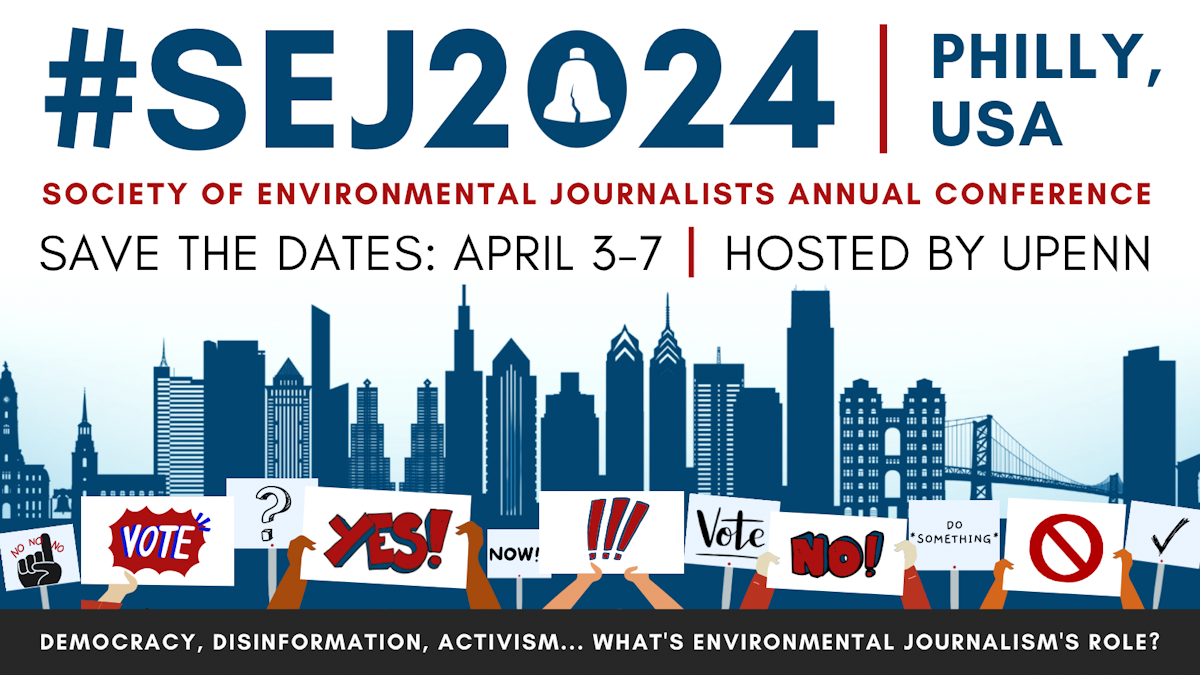 |
| Agenda | Coverage | Travel/Lodging | Sponsors / Exhibitors | About Philly |












 Advertisement
Advertisement 



